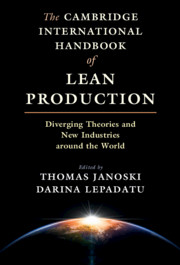 The Cambridge International Handbook of Lean Production
The Cambridge International Handbook of Lean Production Book contents
- The Cambridge International Handbook of Lean Production
- The Cambridge International Handbook of Lean Production
- Copyright page
- Dedication
- Contents
- Tables
- Figures and Sidebars
- Preface
- Acknowledgments
- Contributors
- Abbreviations
- 1 Lean Production as the Dominant Division of Labor
- Part I Theories of Lean Production
- Part II Lean Production across Industries
- 7 Challenges to Lean Implementation from a True Lean Toyota Production System Perspective
- 8 Lean Production in the Automotive Industry
- 9 Product and Process Innovation to Power the Lean Enterprise
- 10 Using a Lean Six Sigma Strategy to Be Resilient in the Telecommunications Sector
- 11 Lean Transformation in Healthcare
- 12 The Adoption of Lean Thinking by Legal Services Providers
- 13 Lean in Public Services
- 14 Mass Merchandizing and Lean Production at Walmart, Costco, and Amazon
- 15 Lean Management Systems and the Use of Financial Information
- 16 Lean Workflow and Quality Assurance when Creating Software-Intensive Products and Services
- Part III Lean Production Around the World
- Name Index
- Subject Index
- References
10 - Using a Lean Six Sigma Strategy to Be Resilient in the Telecommunications Sector
Examples from Ericsson AB
from Part II - Lean Production across Industries
Published online by Cambridge University Press: 11 March 2021
- The Cambridge International Handbook of Lean Production
- The Cambridge International Handbook of Lean Production
- Copyright page
- Dedication
- Contents
- Tables
- Figures and Sidebars
- Preface
- Acknowledgments
- Contributors
- Abbreviations
- 1 Lean Production as the Dominant Division of Labor
- Part I Theories of Lean Production
- Part II Lean Production across Industries
- 7 Challenges to Lean Implementation from a True Lean Toyota Production System Perspective
- 8 Lean Production in the Automotive Industry
- 9 Product and Process Innovation to Power the Lean Enterprise
- 10 Using a Lean Six Sigma Strategy to Be Resilient in the Telecommunications Sector
- 11 Lean Transformation in Healthcare
- 12 The Adoption of Lean Thinking by Legal Services Providers
- 13 Lean in Public Services
- 14 Mass Merchandizing and Lean Production at Walmart, Costco, and Amazon
- 15 Lean Management Systems and the Use of Financial Information
- 16 Lean Workflow and Quality Assurance when Creating Software-Intensive Products and Services
- Part III Lean Production Around the World
- Name Index
- Subject Index
- References
Summary
The above quotation by Charles Darwin is particularly relevant to the telecommunications sector, especially producers of mobile phones. The leading companies in this field have been changing in recent decades, even from year to year. Two decades ago, Ericsson, Nokia, and Motorola enjoyed total domination of the mobile phone market, having over 80 per cent of the market share, and Nokia was the largest phone company as a result of its customer focus and innovative solutions.
Information
- Type
- Chapter
- Information
- The Cambridge International Handbook of Lean ProductionDiverging Theories and New Industries around the World, pp. 245 - 270Publisher: Cambridge University PressPrint publication year: 2021